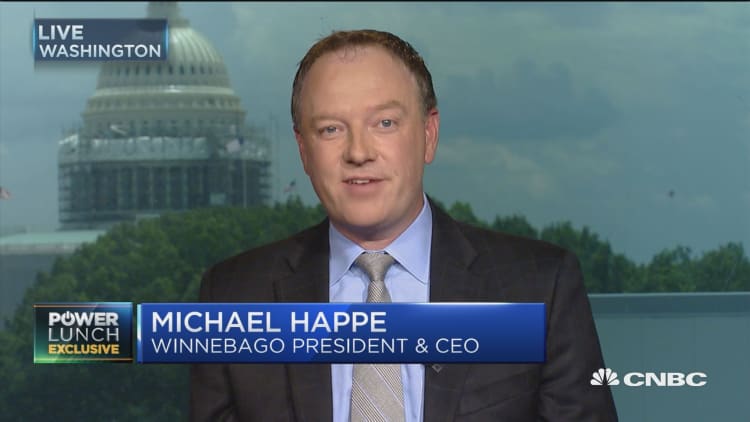
Recreational vehicles, better known as RVs, are no longer just for retired grandparents with wanderlust.
After a swan dive in the aftermath of the 2008 financial crisis, the RV industry is rebounding with ownership at the highest level in a decade. The increased interest in mobile living has sent shares of RV-maker Winnebago up in tandem, something that CEO Michael Happe says has plenty of room to go.
"The industry has now grown seven straight years in 2016 and we're about to set an all-time record high again," Happe told CNBC's "Power Lunch" this week. "The industry has rebounded to levels that have exceeded the previous highs."
Mobile home ownership is at its highest number since 2005, according to a report from the Recreation Vehicle Industry Association. Year to date, total RV shipments reached the highest starting number to any year since 2006, their second-best start since 1977, the RVIA added.
Sales of RVs climbed by more than 11 percent in the first quarter of 2016, according to the organization's March survey of RV manufacturers.
Shares of Winnebago are up nearly 27 percent since Happe took the wheel on January 18 of this year. He cited a strengthening economy, more access to financing and low fuel prices for Winnebago's success as factors behind the recent uptick in RV ownership. He also mentioned that new technology is also a key part of the turnaround.
"The products are getting better, the amenities of your home are starting to make their home into the RV industry in a big way, the electronics and the technology is present."
The RVIA recently noted that the fastest growing segment of RV owners was among those between the ages of 35-44, undermining a stereotype that the vehicles often appeal to older drivers. Indeed, many of the latest RV features seem designed with that in mind.
Winnebago RVs typically sell for $80,000 to $450,000. The higher-end motor homes offer GPS, Sirius XM radio, heat and massage cab seats, stainless steel appliances and collision avoidance systems.
Happe also pointed to less luxurious homes for younger buyers for whom cost might be an issue, as well as those seeking a more rugged, outdoor experience.
"The outdoor lifestyle is attracting more and more people interested in investing in the space," Happe said. "We are seeing the average age of the RV consumer decrease as more people explore the great places around the United States."
But the demographic is largely still baby boomers. The average age shifted down a year since 2005, to 48 years old in 2011, according to RVIA.


